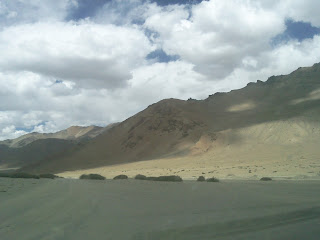Ladakh in Modern Times....
By the beginning of the 19th century, the Mughal empire had collapsed, and Sikh rule had been established in Punjab and Kashmir. However the Dogra region of Jammu remained under its Rajput rulers, the greatest of whom was Maharaja Gulab Singh whose General Zorawar Singh invaded Ladakh in 1834. King Tshespal Namgyal was dethroned and exiled to Stok. Ladakh came under Dogra rule and was incorporated into the state of Jammu and Kashmir in 1846. It still maintained considerable autonomy and relations with Tibet. During the Sino-Sikh war (1841-1842), the Qing Empire invaded Ladakh but the Sino-Tibetan army was defeated.
In 1947, partition left Ladakh a part of the Indian state of Jammu and Kashmir, to be administered from Srinagar. In 1948, Pakistani raiders invaded Ladakh and occupied Kargil and Zanskar, reaching within 30 km of Leh.Reinforcement troops were sent in by air, and a battalion of Gurkhas made its way slowly to Leh on foot from south. Kargil was a scene of fighting again in 1965, 1971, and 1999.
In 1949, China closed the border between Nubra and Sinkiang, blocking the 1000-year old trade route from India to Central Asia. In 1950, China invaded Tibet, and thousands of Tibetans, including the Dalai Lama sought refuge in India. In 1962, China occupied Aksai Chin, and promptly built roads connecting Sinkiang and Tibet, and the Karakoram Highway, jointly with Pakistan. India built the Srinagar-Leh highway during this period, cutting the journey time between Srinagar to Leh from 16 days to two. Simultaneously, China closed the Ladakh-Tibet border, ending the 700-year old Ladakh-Tibet relationship.
Since the early 1960s the number of immigrants from Tibet (including Changpa nomads) have increased as they flee the occupation of their homeland by the Chinese. Today, Leh has some 3,500 refugees from Tibet. They hold no passports, only customs papers. Some Tibetan refugees in Ladakh claim dual Tibetan/Indian citizenship, although their Indian citizenship is unofficial. Since partition Ladakh has been governed by the State government based in Srinagar, never to the complete satisfaction of the Ladakhis, who demand that Ladakh be directly governed from New Delhi as a Union Territory. They allege continued apathy, Muslim bias, and corruption of the state government as reasons for their demands. In 1989, there were violent riots between Buddhists and Muslims, provoking the Ladakh Buddhist Council to call for a social and economic boycott of Muslims, which was lifted in 1992. In October 1993, the Indian government and the State government agreed to grant Ladakh the status of Autonomous Hill Council. In 1995, the Ladakh Autonomous Hill Development Council was created.
The Dynasty simplifies the beauty of its nature and vast enormous rich lavishing panoramic experience.




